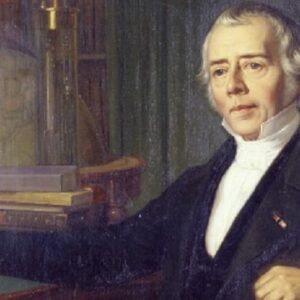Hans Christian Oersted, a Danish chemist and physicist, revolutionized electromagnetism when he discovered that electric currents may generate magnetic fields. Hans was surrounded by scientific machinery as a child because his father was a chemist. This piqued his interest in science. As a child, he learned various languages and later attended the University of Copenhagen, where he majored in physics and philosophy. He graduated with a bachelor’s degree in pharmacy and went on to earn a doctorate in philosophy. Hans traveled the world, visiting a number of well-known scientists before accepting a position at the university. He gave numerous lectures and was astounded to discover that a magnetic needle aligns in a perpendicular position with a current carrying wire during one of them. This discovery provided his foundation for understanding the relationship between magnetism and electricity. Despite the fact that Hans never attempted to describe electromagnetic using mathematical equations, it was a momentous accomplishment that spawned a slew of electromagnetism-related studies and study. He made yet another scientific breakthrough when he discovered aluminum, separated it from various chemical compounds, and extracted it as a single element. His life’s work was to make science more accessible to the general public, rather than keeping it confined to academic and professional circles.
Childhood and Adolescence
Hans was born in the Danish town of Rudkobing on August 14, 1777. Hans’ father, Soren Christian Oersted, was a practicing pharmacist, and as a child, he assisted his father in the family company while learning about chemistry and science.
Hans and his younger brother Anders were transferred to live with a German wigmaker and his wife because their father was preoccupied with business and their mother was involved with a large family. During this time, the two brothers learned German, as well as rudimentary Latin, French, and mathematics.
The family moved to Copenhagen when they were 17 years old, and both brothers passed the University admission examination with honors. Hans majored in physics, astronomy, chemistry, and mathematics at university. Hans was heavily influenced by Kantian philosophy and zealously advocated all of his views. He obtained his bachelor’s degree in pharmacy with honors in 1797.
The next year, he joined the editorial board of ‘Philosophisk repertorium for faedrelandets nyeste litteratur,’ but his tenure was brief. The fact that this publication was known for defending Kantian philosophy piqued his interest in it.
He got his doctorate in 1799, and in his thesis, he discussed the significance and application of Kantian philosophy in natural philosophy.
Hans began his career as a pharmacy manager for a few days before leaving in 1801 to travel and expand his scientific expertise. Johann Ritter, who was studying on the chemical consequences of current electricity, was introduced to him at Gottingen. Ritter’s unconventional ideas inspired Hans to come up with his own.
He met Henrik Steffens and Franz Baader in Berlin, and read Schelling. Throughout his trip, he worked with brilliant brains who inspired his philosophical ideas.
When the scholar defended Ritter’s work in Paris, the first spark of scientific endeavor was recognized in him.
Despite the criticism he received, he learned one essential lesson. Many of the things he thought were scientifically proved turned out to be nothing more than figments of his imagination.
He returned to Copenhagen in 1804, but was unhappy when he was not awarded a professorship. He began giving public lectures, which quickly became very famous, and in 1806 he was awarded a position at the ‘University of Copenhagen.’ Over the next few years, he established himself as a scientist, publishing multiple papers.
He published a paper establishing the link between electrical and chemical forces in 1812 while conducting research in Berlin.
He discovered that a magnetic needle aligns in a perpendicular position with a current carrying wire while experimenting in 1820. The force of electromagnetism was discovered as a result of further inquiry.
Hans established a society in 1824 with the goal of improving public awareness of scientific knowledge.
In the year 1825, he was the first to reduce aluminum chloride to acquire aluminum in its elemental form.
Oersted founded the ‘Den Polytekniske Lreanstal’ in 1829, which is now known as the ‘Technical University of Denmark.’
Major Projects of Hans Christian Ørsted
The link between magnetism and electricity was undoubtedly his most important discovery. Hans was also the one who discovered piperine, the pepper’s pungent component. In the world of chemistry, his discovery of aluminum is regarded as a great achievement.
Achievements & Awards
Hans was a ‘Knight of the Prussian Order of Merit’ and the ‘Secretary of the Royal Society of Sciences in Copenhagen.’ He was also a member of the prestigious ‘French Legion of Honour.’
The erudite scientist was honored with the ‘Copley Medal’ by the ‘Royal Society of London’ in 1820 for his contributions to science. Hans was elected as a foreign member of the ‘Royal Swedish Academy of Sciences’ in 1822.
Personal History and Legacy
The Danish government created a national holiday in November 1850 to honor this distinguished scientist and his efforts at the ‘University of Copenhagen.’ Oersted died in Copenhagen on March 9th, 1851, at the age of 73, and his funeral was attended by all of Denmark’s notables.
As a scientist, Oersted was more concerned with disseminating scientific knowledge to the general public rather than keeping it confined to academic institutions and research laboratories. Since 1908, the association formed by this prominent scientist, ‘Selskabet for Naturlrens Udbredelse,’ has been giving ‘Oersted Medals’ to Danish physical scientists who have made remarkable contributions in the field. In the 1930s, he was given the moniker ‘Oersted,’ which is now used to define a unit of magnetic field strength.
Estimated Net Worth
The estimated net worth of Hans Christian Ørsted is not available


